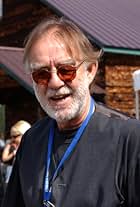Godfrey Reggio (original) (raw)

Godfrey Reggio is a pioneer of a film style that creates poetic images of extraordinary emotional impact for audiences worldwide. Reggio is prominent in the film world for his QATSI trilogy, essays of visual images and sound that chronicle the destructive impact of the modern world on the environment. Reggio, who spent 14 years in silence and prayer while studying to be a monk, has a history of service not only to the environment but to youth street gangs, the poor, and the community as well.
Born in New Orleans in 1940 and raised in southwest Louisiana, Reggio entered the Christian Brothers, a Roman Catholic pontifical order, at age 14. He spent 14 years of his adolescence and early adulthood in fasting, silence, and prayer. Based in New Mexico during the 1960s, Reggio taught grade school, secondary school, and college. In 1963, he co-founded Young Citizens for Action, a community organization project that aided juvenile street gangs. Following this, Reggio co-founded La Clinica de la Gente, a facility that provided medical care to 12,000 community members in Santa Fe, and La Gente, a community-organizing project in Northern New Mexico's barrios. In 1972, he co-founded the Institute for Regional Education in Santa Fe, a non-profit foundation focused on media development, the arts, community organization, and research. In 1974 and 1975, with funding from the American Civil Liberties Union, Reggio co-organized a multi-media public interest campaign on the invasion of privacy and the use of technology to control behavior.
_Koyaanisqatsi (1983)_, Reggio's debut as a film director and producer, is the first film of the QATSI trilogy. The title is a Hopi word meaning "life out of balance." Created between 1975 and 1982, the film is an apocalyptic vision of the collision of two different worlds--urban life and technology versus the environment. The musical score was composed by renowned composer Philip Glass. Powaqqatsi (1988), Reggio's second film, conveys a humanist philosophy about the earth, the encroachment of technology on nature and ancient cultures, and the splendor that disappears as a result. The film focuses on the so-called modern way of life and the concept of the Global Village, entwining the distinctive textures of ancient and so-called Third World cultures. Powaqqatsi was co-written, co-produced and directed by Reggio and had music composed by Philip Glassbetween 1985 and 1987. In 1991 Reggio directed Anima Mundi (1991), a film commissioned by Bulgari, the Italian jewelry company, for the World Wide Fund for Nature, which used the film for its Biological Diversity Program. Accompanied by the music of Philip Glass, the 28-minute Anima Mundi is a montage of intimate images of over seventy animal species that celebrates the magnificence and variety of the world's fauna.
In 1993, Reggio was invited to develop a new school of exploration and production in the arts, technology, and mass media being founded by the Benetton company. Called Abrica--Future, Presente, it opened in May 1995, in Treviso, Italy, just outside Venice. While serving as the initial director of the school through 1995, Reggio co-authored the 7-minute film Evidence (1995) that provides another point of view to observe the subtle but profound effects of modern living on children. In 2002, Godfrey Reggio completed Naqoyqatsi (2002), the final film of the QATSI trilogy, again with music by Philip Glass. Currently, Reggio is in the initial stages of production on a new film, working with a narrative structure for the first time, that will explore the negative impact that consumerism and fundamentalism has had on the world. He resides in Santa Fe, New Mexico, and is a frequent lecturer on philosophy, technology, and film.
Photos
Suggest an edit or add missing content

